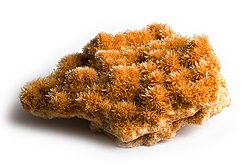Lake Torrens National Park
Lake Torrens National Park is a national park in South Australia, 345 km north of Adelaide. The park protects the area around Lake Torrens, which is a large, dry, salt lake covering an area of 5,700 square kilometres. The lake is part of a large rift valley that also includes Spencer Gulf. Lake Torrens has been filled with water twice in the last 150 years.
| Lake Torrens National Park | |
|---|---|
IUCN Category Ia (Strict Nature Reserve)
| |
| Nearest town/city | Woomera |
| Coordinates | 31°02′40″S 137°51′35″E / 31.04444°S 137.85972°E |
| Area | 5,677 km² |
| Established | 1991 |
| Managing authorities | Department for Environment and Heritage |
| Official site | Lake Torrens National Park pdf |
The lake filled in 2010 and attracted a large number of birds, including 150,000 Banded Stilts.[1] This bird can only breed on islands in flooded salt lakes and have only bred in South Australia seven times in the last 70 years.[1] The last known breeding was at Lake Eyre in 2000.[1] During dry times the stilts live at the Coorong Lakes waiting for the salt lakes to flood.[1]
History
The first European to find Lake Torrens was Edward John Eyre in 1839. For many years it was believed that Lake Torrens was a large horseshoe-shaped salt lake in the northern Flinders Ranges. This salt lake blocked any path to the interior. The first European to get through this barrier was A. C. Gregory from the north in March 1858.
Later in 1858, an expedition under Benjamin Herschel Babbage and Major Warburton in the north-west also crossed the non-existent barrier near modern Marree. Eyre's horseshoe lake was actually made up of six large salt lakes; Lake Frome, Lake Callabonna, Lake Blanche, Lake Gregory, Lake Eyre South, and Lake Torrens itself.
References
| Wikimedia Commons has media related to Lua error in Module:Commons_link at line 62: attempt to index field 'wikibase' (a nil value).. |
- ↑ 1.0 1.1 1.2 1.3 Elder, John (11 July 2010). "Rain's blessing: stilt chicks take their first steps". theage.com.au. Retrieved 22 May 2011.

